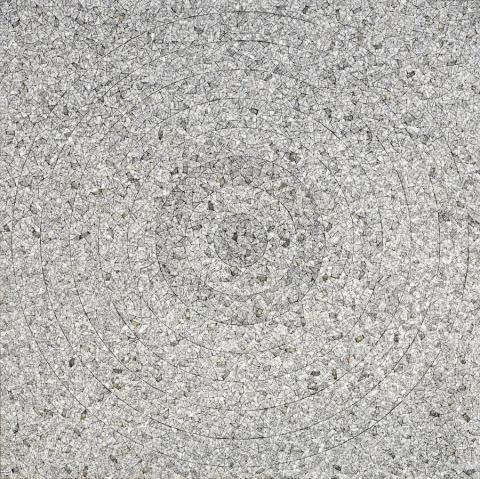AGGREGATION 03-AU136, 2003
KWANG-YOUNG CHUN
mixed media with Korean mulberry paper
202.0 x 202.0 cm
signed, titled and dated verso: (Korean characters) / CHUN, KWANG YOUNG / AGGREGATION (Korean characters) 03-AU136 / ... / -03 K.Ychun
Connie Dietschold Gallery, Sydney
Private collection, Sydney
Aggregation 001–AP041, 2001, mixed media with Korean mulberry paper, 202.0 x 202.0 cm, in Oh, Kwang–Su (et al), CHUN, Kwang–Young: Artists of the Year 2001, National Museum of Contemporary Art, Korea, 2001, pp. 92–93 (illus.)
Born in 1944 when Korea was on the cusp of modernisation, Kwang-Young Chun's childhood experiences of a country in the midst of enormous transformation form an important foundation for his art practice. The 1950s in Korea saw the peninsula divided by war with economic devastation in both the North and South. As the South rebuilt, it transitioned politically from authoritarianism to democracy resulting in a period now known as the 'age of explosive energy'. Cultural life in South Korea underwent fundamental changes in its structures and customs with a booming popular culture facilitated by widespread industrialisation.
This period of great upheaval transfigured Chun's early life with his family in rural Korea. Naturally inquisitive, the broadening in Korean life resulted in opportunities for the young Chun, ultimately resulting in a scholarship to study in America at the Philadelphia School of Art. Exposed to the work of the Colour Field painters, the impact of the broader Pluralism movement undoubtedly shaped Chun's visual language. Returning to Korea in the late 1970s, Chun explored the reductive theories of Colour Field for over a decade before moving away from the painterly surface to the first of his Aggregations in 1994.
Constructed from carved polystyrene foam wedges wrapped in Korean mulberry paper, the Aggregate assemblages straddle both the international post-formalism which framed Chun's university years and the aesthetic of pre-modern Korea where mulberry paper performed a variety of functions. In addition to book printing, mulberry paper was used prior to the introduction of refrigeration in the late 1950s for the wrapping of food and medicinal herbs. The resulting bundles would be hung from rafters; a visual reference from Chun's childhood visits to a relative's traditional dispensary where the tightly clustered parcels obscured the ceilings.
For over 15 years Chun has explored the ideas and optical effects of these assemblages, each titled 'Aggregate' and numbered as part of the artist's categorical system. The massed geometric bundles in Aggregate 03-AU136, compressed into ecliptic planes around a central form, have a combined tonal value far greater than the parts. Colour is suggested through form and repetition, a style employed in Eastern scroll painting whereby the presence of colour is implied by its absence. In his essay on the artist The Unknown Stratosphere, critic Robert C. Morgan described the Aggregate series as a 'tour-de-force not only because of their cultural and historical references, but also due to the manner in which the appropriated use of mulberry papers with varied ink surfaces revive the notion of implied colour in painting, once well known by the great tradition of Korean landscape painting of the past.'1
1. Morgan, R.C., The Unknown Stratosphere, Kwang Young Chun, Kukje Gallery, Seoul, 2005
MERRYN SCHRIEVER
